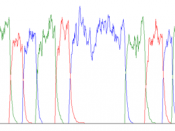SIMULATION IDEAS BLIND -Blindfolded to feel braille, walk around space, FINE MOTOR ISSUES - Put on rubber gloves and then try to tie shoes or button a shirt or put socks on their hands and have them try to pick up a dime. SENSORY ISSUES - Try on gloves with scratch paper or stick a small piece of scratch paper on the inside of their clothing/ label tags. ADD/ADHD - Listen to a story on headphones while at the same time having somebody ask them about their favorite school subject/food/movie to experience what kids with auditory-processing problems might face, etc. DEAF/ HEARING - Put cotton balls in their ears and then listen to instructions at each station. MOBILITY/ FLEXIBILITY ISSUES - Have participants try to pull a sticker off their back without raising their arms above their chests (e.g., loss of flexibility). VISION PROBLEMS - Have participants put on non-prescription glasses covered with petroleum jelly and try to read a label on a pill or cough medicine bottle (e.g., blurred vision). For those participants with glasses, you can place plastic wrap over their glasses for a similar effect. VISION PROBLEMS - Have children hold a large distorted magnifying lens and have them walk on a line of tape on the floor that is hard to see through the lens. DYSLEXIA - Have participants try to read or draw by looking through a mirror, seeing what someone with dyslexia might see. Display braces to use Display adaptive technology to use Display adaptive devices to use Sit in a wheelchair, use crutches, etc. Assistive dogs Lower limb mobility: Tie a dowel or ruler to the back of the leg so that the leg could not bend. Try putting on trousers, shorts, socks, shoes etc. Walk upstairs. Join in a game which involves...
More Art Essays
essays:
"All My Sons" by Arthur Miller
... some time. Arthur Miller is showing the audience that with the destruction of this tree, all must be forgotten. The previous accounts ... acts or their personality in the play. I just got the feeling that it was drug out and could have been brought to a close sooner than it did. Approaching the middle of ...
George Braque - Write up of trip to Braque expedition
... , very nice Write up of trip to Braque expedition Before going to this exhibition, my knowledge of Braque was very low, I knew only of his relationship with Pablo Picasso. With this in mind, and my interest in Picasso's work with Braque on cubism, I ...
Western Art History
... of the first times that the human body has succesfully been sculpted in the act of motion. The arms of the figure form a half circle that meets another opposing half circle formed by the curve of the body. The proportions of ...
What impact has technology had on architecture of the 20th century? - mainly notes
... American cities profoundly by allowing greater density through higher buildings. Imagine the typical office floor plate as we know it: open space with a few columns. You couldn't go as high or have such long spans between columns with ... modernism in art with its eradication of representation beyond the ...
Ingres' "La Grande Odalisque" and Manet's "Olympia" - a Comparison
... Manet, being reluctant to follow the trends before him, "refused to create three-dimensionality through modeling forms with lines or gradations of color." "Olympia" is proof of this refusal; her body almost seems like a cardboard cut-out. Another notable difference between "Olympia ...


